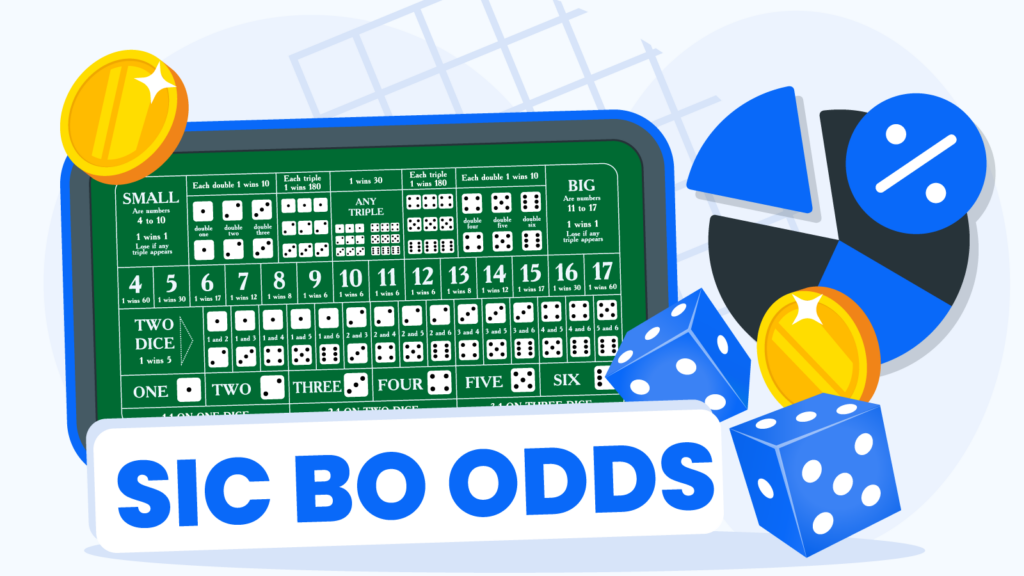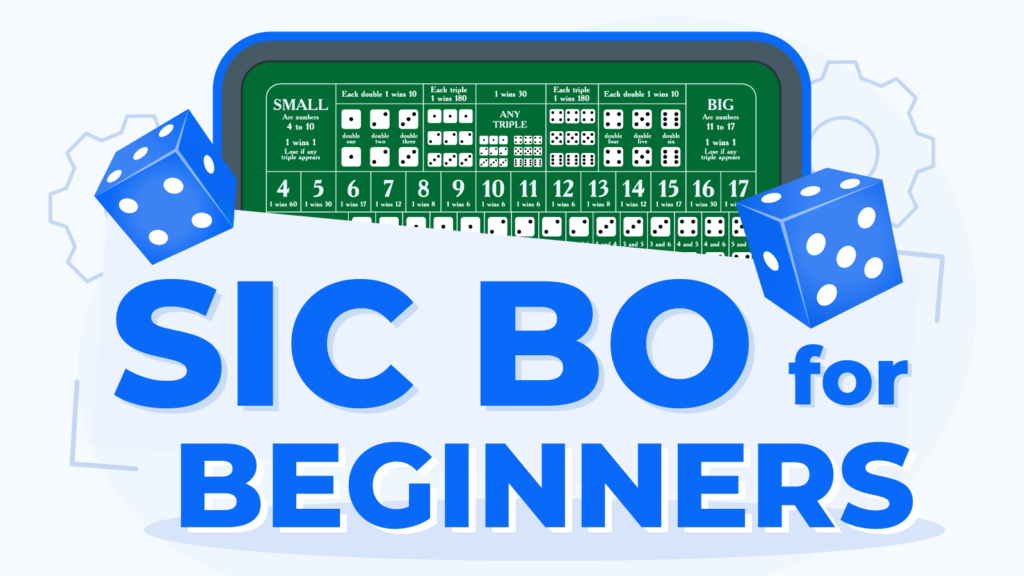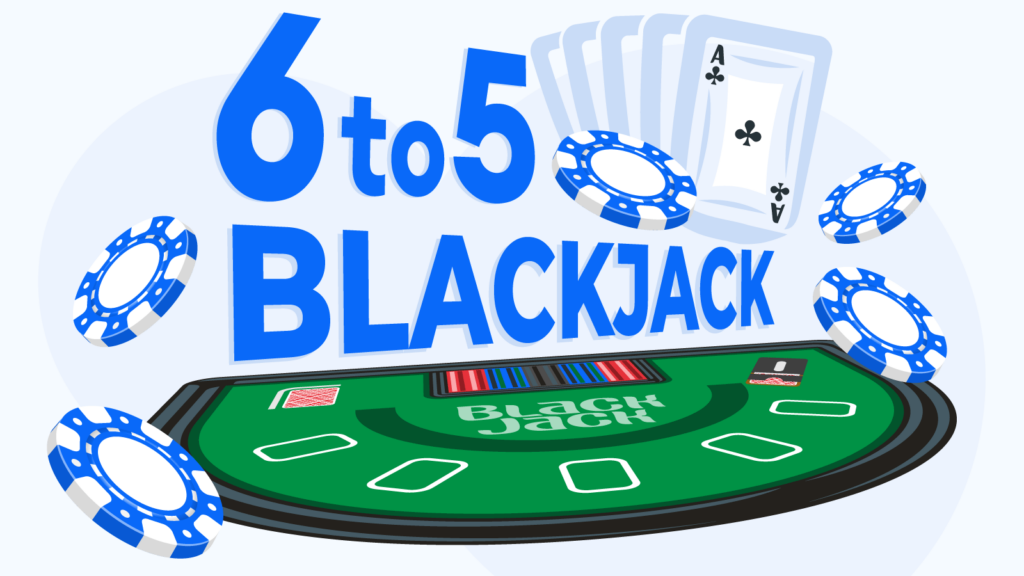
Expert Insights into 6 to 5 Blackjack: Strategy and Payout Guide
All the information in this page was checked by:
All the information we present is verified by our team of casino reviewers using multiple sources. We commit to a high level of accuracy and reliability.
We have paid partnerships with the online casino operators featured on our site. We also earn commissions when you, the user, click on certain casino links. These financial partnerships do not affect our reviews, recommendations, or analysis. We remain committed to delivering unbiased gambling reviews. For more details, visit our Advertiser Disclosure page.
A £10 blackjack should pay £15. At 6 to 5 tables, you’ll only get £12. That £3 difference happens every time you hit 21, something that costs the average UK player £50-£100 per session. The blackjack game rules remain the same, but mathematically, you’re playing something far worse. We’ll show you exactly how 6:5 blackjack works and why you should avoid it.
- The True Impact of 6 to 5 Blackjack Payouts: What You Need to Know
- Easy Ways to Calculate 6 to 5 Blackjack Payouts
- Why the 6 to 5 Blackjack Payout Chart is Essential for Players
- Comparing 6 to 5 vs 3 to 2 Blackjack: How It Affects Your Winnings
- Tips to Improve Your Odds in 6 to 5 Blackjack
- Is 6 to 5 Blackjack Worth Playing? Here’s What to Consider
Why UK Players Should Avoid 6 to 5 Blackjack Tables
The UK gambling market has traditionally offered some of the fairest blackjack games in Europe, but that’s changing. Over the past five years, 6 to 5 blackjack has quietly infiltrated both online platforms and brick-and-mortar casinos across Britain.
The UK Blackjack Landscape: A Changing Reality
Online Casinos:
- Approximately 35-40% of UK-licensed online casinos now offer at least one 6:5 blackjack variant
- These games are often disguised as “Single Deck Blackjack” or “Speed Blackjack”
- Lower minimum bets (£1-£5) are used to attract casual players
- Many mobile-optimized games default to 6:5 payouts
Land-Based Casinos:
- Major UK casino chains have introduced 6:5 tables in tourist-heavy locations
- London casinos, particularly near Leicester Square and Piccadilly, increasingly feature 6:5 games
- Regional casinos in Manchester, Birmingham, and Glasgow have followed suit
- Lower-stakes tables (£5-£10 minimums) are most likely to be 6:5
Financial Impact for UK Players
Let’s put this in perspective with typical UK betting patterns:
| Player Type | Typical Bet | Blackjacks/Hour | Loss per Hour (6:5 vs 3:2) |
|---|---|---|---|
| Casual (£5) | £5 | 3-4 | £4.50 – £6.00 |
| Regular (£10) | £10 | 3-4 | £9.00 – £12.00 |
| Serious (£25) | £25 | 3-4 | £22.50 – £30.00 |
| High Roller (£100) | £100 | 3-4 | £90.00 – £120.00 |
For a typical UK player betting £10 per hand over a 4-hour Saturday evening session:
- Expected blackjacks: 12-16
- Additional loss at 6:5 table: £36-£48
- Annual loss (monthly play): £432-£576
UK-Specific Red Flags
Watch out for these tactics commonly used in UK casinos:
- “British Blackjack” or “London Blackjack” – Marketing names that disguise 6:5 payouts
- Low minimum tables in high-traffic areas – Positioned to catch casual tourists
- Mobile app defaults – Many UK casino apps default to 6:5 games
- “Fast Deal” or “Speed” variants – Often use 6:5 to offset the faster play rate
- Promotional tables – “Special offer” tables may have worse payouts
Better Alternatives for UK Players
Instead of accepting 6:5 tables, UK players have excellent alternatives:
Online Options:
- Seek out casinos that explicitly advertise “3:2 Blackjack“
- Look for European-style blackjack variants
- Check live dealer tables (often maintain 3:2 standards)
- Read game rules before depositing
Land-Based Options:
- Ask the pit boss for 3:2 tables specifically
- Visit casinos during off-peak hours when better tables are available
- Consider membership clubs that offer better game conditions
- Travel to casinos outside tourist areas
Bottom Line for UK Players: You have better options. Don’t settle for 6:5 blackjack when 3:2 tables are available. The UK market is competitive enough that you can demand better conditions and casinos that value long-term players will provide them.
The True Impact of 6 to 5 Blackjack Payouts: What You Need to Know
With the 6:5 blackjack payout rule, the game’s mathematics changes. To understand why this matters, we need to break down exactly what this ratio means and how it affects your bottom line.
Understanding the Payout Ratio
In traditional blackjack, a “natural” or “blackjack” (an Ace plus a 10-value card as your first two cards) pays 3 to 2. This means:
- For every £2 you bet, you win £3
- A £10 bet wins £15
- A £20 bet wins £30
With 6 to 5 blackjack, that same natural blackjack pays 6 to 5:
- For every £5 you bet, you win £6
- A £10 bet wins £12
- A £20 bet wins £24
The difference is that you’re receiving £3 less for every £10 blackjack. That’s a 20% reduction in your winnings on the best possible hand.
Why This Rule Exists
The motivation from the operators’ point of view is simply profit maximization.
Casino Profit Analysis:
| Table Type | House Edge | Casino Profit per £100 Wagered |
|---|---|---|
| 3:2 Blackjack | ~0.5% | £0.50 |
| 6:5 Blackjack | ~2.0% | £2.00 |
| Increase | +300% | +£1.50 |
For a busy casino table dealing 60 hands per hour with an average bet of £15:
- 3:2 table: £45/hour profit
- 6:5 table: £180/hour profit
- Difference: £135/hour more profit
Over a year, that’s over £1 million additional profit per table. Now you understand why casinos push these games.
Easy Ways to Calculate 6 to 5 Blackjack Payouts
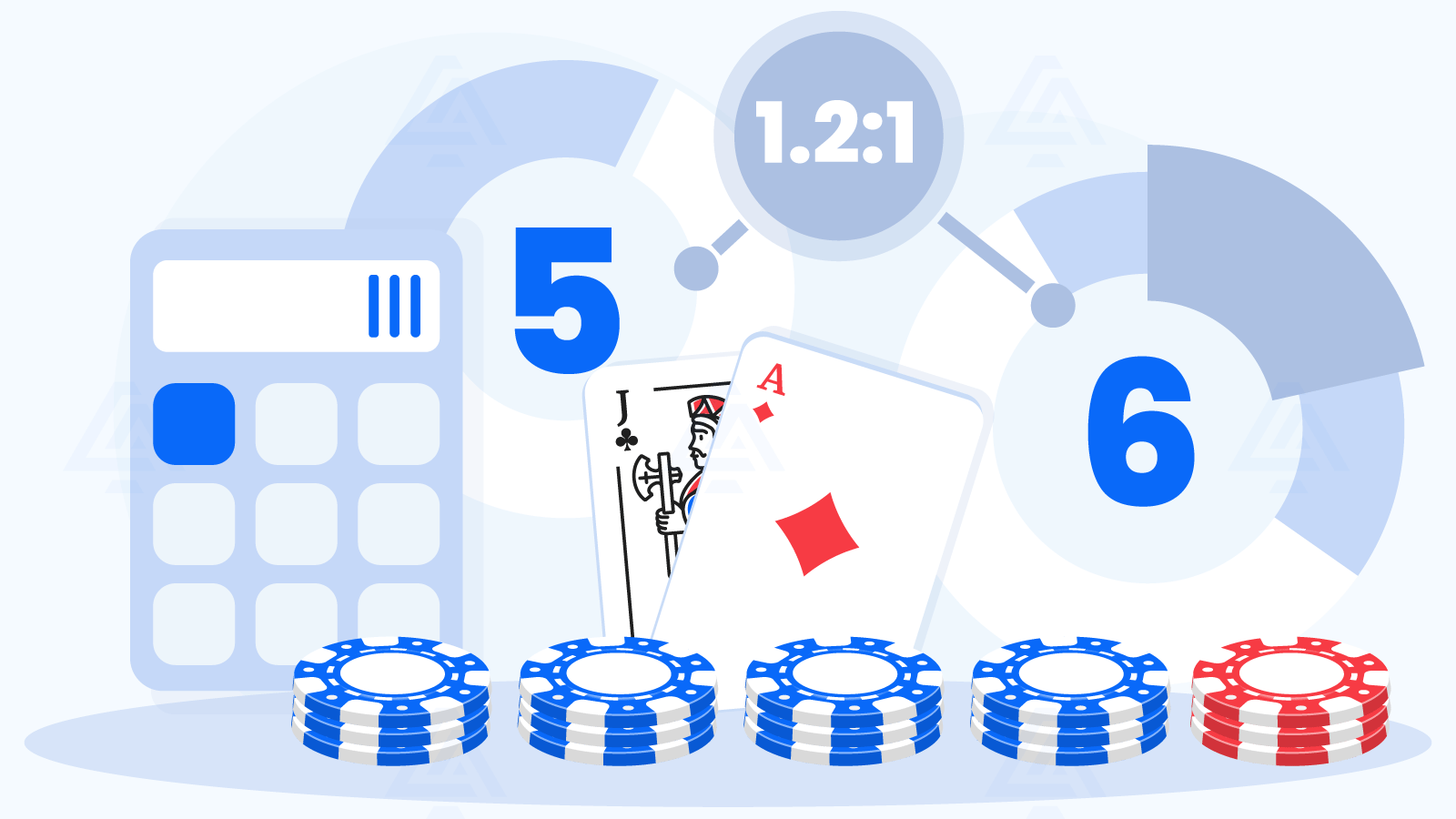
Steps to calculating the payout
- You take the amount you staked initially and divide it by 5
- You then multiply the resulting value by 6
- This new amount equals the payout you receive if you have a 21 hand
Alternative formulation for the payout
Instead of writing it as 6:5, Blackjack payouts can be simplified to a formulation that does not imply dividing your bet.
Tip
We can equivalently write 6:5 as 1.2:1. In this case, you can simply determine your payouts by multiplying your original stake by 1.2. While simpler, from an algorithmic point of view, 1.2 to 1 is harder to memorise. You should learn the standard calculating procedure, even with the extra step. Here is a flowchart for calculating the resulting payout amount to make you remember it more manageable.
Avoid this Common Calculation Mistake: Rounding Errors with Odd Bets
6:5 payouts create problems with bets that aren’t multiples of £5:
| Bet Amount | Exact 6:5 Payout | What Casinos Pay | You Lose |
|---|---|---|---|
| £3 | £3.60 | £3.00 | £0.60 |
| £7 | £8.40 | £8.00 | £0.40 |
| £12 | £14.40 | £14.00 | £0.40 |
| £13 | £15.60 | £15.00 | £0.60 |
Why this happens: Casinos round down to avoid dealing with small change, costing you even more.
Solution: Always bet in multiples of £5 at 6:5 tables to avoid additional rounding losses.
Quick Mental Math Tricks
For faster calculations, convert 6:5 to a decimal multiplier:
6 ÷ 5 = 1.2
Simply multiply your bet by 1.2:
- £10 × 1.2 = £12
- £25 × 1.2 = £30
- £50 × 1.2 = £60
- £100 × 1.2 = £120
Pro Tip: Think of it as your bet plus 20% of your bet:
- £10 bet = £10 + £2 (20%) = £12
- £25 bet = £25 + £5 (20%) = £30
6 to 5 Blackjack payout chart

Here is how Blackjack pays 6:5 for £10
We assume that you initially stake £10 in a round. Once the dealer imparts your cards, your hand totals 21. Good job, you have won. As for how much, here is the previous algorithm in motion: you divide the £10 by five and get £2. Then you multiply the £2 by 6. Your eventual payout would be £12. This payout does not include the original stake that you also recover.
21 payout vs winning with standard hands
Winning with a hand valued under 21 generally has a 1 to 1 payout. Essentially, the payout matches your stake. In other words, for the £10 example, the payout for non-Blackjack wins is £10. Thus, a round in which your cards total 21 will always pay better. Here are more examples of possible payouts for a 21 hand when Blackjack pays 6:5.
6:5 Blackjack payout chart for various values
| Original bet | The payout |
|---|---|
| £1 | £1.2 |
| £2 | £2.4 |
| £5 | £6 |
| £10 | £12 |
| £15 | £18 |
| £20 | £24 |
| £25 | £30 |
| £50 | £60 |
| £100 | £120 |
| £150 | £180 |
| £200 | £240 |
| £500 | £600 |
| £1000 | £1200 |
How to tell 6 to 5 Blackjack tables from others?
You don’t even have to ask the dealer if a game has the Blackjack pays 6:5 rule. All games will have the 21-payout specified on the felt table.
The Real Cost: 6 to 5 vs 3 to 2 Blackjack Over Time

The true damage of 6:5 blackjack isn’t visible in a single hand or even a single session. It’s the cumulative effect over time that devastates your bankroll.
Hourly Loss Rate Comparison
Blackjack is typically dealt at 60-80 hands per hour. Let’s use 70 hands/hour as our baseline.
If you play around 70 hands an hour, you can expect roughly 3.3 blackjacks per session. Now, here’s where payout structure matters: with a £10 bet per hand, the standard 3:2 payout earns you £50 in blackjack wins per hour on average, while the 6:5 version nets only £40, a £10 loss just for playing the wrong table.
Scale that up to a £25 per hand player, and the difference grows fast. You’d miss out on about £25 per hour simply because of the weaker payout rule.
Annual Impact for Regular Players
Let’s examine different player profiles and their annual losses:
The Casual Weekend Player
Someone who plays twice a month for about three hours at £10 per hand might not think the payout rule matters much. But over a full year—roughly 72 hours of play—the weaker 6:5 rule quietly eats away at winnings, costing about £720 more than if they’d played 3:2 blackjack.
The Regular Enthusiast
Playing weekly at £15 a hand for four-hour sessions sounds harmless enough, but the math doesn’t lie. Across 208 hours a year, the difference in payout ratios adds up fast, roughly £3,120 lost in potential value simply because of the 6:5 table setup.
The Serious Player
For players who treat blackjack as a steady pastime—three sessions a week, four hours each, at £25 per hand—the financial gap becomes striking. If you play for 624 hours over the year, the reduced payout rule translates into around £15,600 in extra losses, even with the same cards and decisions.
Why Casinos Push 6:5 Tables
Casino operators obviously want you to play 6:5 games over the more favourable ones. So how do they get you to do it?
The “Single Deck” Bait-and-Switch
They will bold the words “Single Deck Blackjack”, as they know players tend to associate fewer decks with better odds. The catch hides in the small print—6:5 payouts. In reality, a single-deck 6:5 game is worse than an 8-deck table paying 3:2.
The Low Minimum Trap
You’ll often see £5 minimum bets on 6:5 tables while 3:2 versions start at £25. This may appear friendlier to a casual player, but the steeper long-term cost is almost always bound to cancel out the fairly cheaper entry. The illusion of affordability works perfectly on budget-conscious players and tourists.
The Speed Game Excuse
Some casinos have been shown to market 6:5 tables as “Speed Blackjack” or “Fast Deal”, claiming faster rounds make up for lower payouts. But in truth, you’re just losing money faster, a marketing twist that benefits the house, not you.
Expert Insight: The shift from 3:2 to 6:5 represents one of the most significant rule changes in blackjack history. This single change transforms blackjack from one of the best casino games into one of the worst.
How to Spot 6 to 5 Blackjack Tables (Online & Live)
Knowing how to identify 6:5 tables before you sit down is crucial. Here’s your complete detection guide.
Visual Indicators on Table Felt (Land-Based Casinos)
When you’re playing at a land-based casino, the felt on the blackjack table tells you everything you need to know about payouts—if you know where to look.
| What to Check | Details |
|---|---|
| Payout Line | Look for clear text on the felt. “Blackjack Pays 3 to 2” or “Blackjack Pays 3:2” means good odds. Avoid any table that says “Blackjack Pays 6 to 5” or “Blackjack Pays 6:5.” |
| Where to Find It | Usually printed in front of the dealer, along the betting circle, or in the table’s center. Some casinos print it in tiny letters near the insurance line, so check closely before sitting down. |
| Design Tricks to Watch For | Some tables use small fonts, light colors, or place the payout info where players rarely look. It might even be partly hidden by chip trays or cards, making it easy to miss. |
Pro Tip: If you the payout isn’t clearly displayed, ask the dealer before placing any bets.
Online Casino Red Flags
Spotting bad blackjack games online takes a few clicks—but knowing where to look can save you real money.
| Category | What to Watch Out For | Tips to Stay Safe |
|---|---|---|
| Game Lobby Clues | Titles like “Single Deck Blackjack,” “Speed Blackjack,” “Fast Deal Blackjack,” or “Blackjack Express.” They often hide 6:5 payouts behind fast play or “single deck” marketing. | Don’t trust names alone. Always check the rules before placing a bet. |
| Payout Information | Casinos often tuck payout details under “i” (info), “Game Rules,” “Help,” “Paytable,” or “Payouts.” | Open these sections before you start. If 6:5 appears anywhere, back out immediately. |
| Software Provider Patterns | Some providers make 6:5 their default, especially in RNG (digital) blackjack. Live dealer versions are more likely to stay 3:2. | Never assume fairness based on brand reputation—verify each game’s payout before playing. |
Questions to Ask Before Playing
At Land-Based Casinos:
- “Does this table pay 3 to 2 or 6 to 5 for blackjack?”
- “Where are your 3 to 2 tables located?”
- “What’s the minimum bet on your 3 to 2 tables?”
- “Are there alternative 3 to 2 tables with lower minimums?”
At Online Casinos:
Contact live chat and ask them which blackjack games pay 3:2 and which ones pay 6:5 before testing them.
Pre-Game Checklist
Before placing your first bet:
- Payout ratio clearly identified (3:2 or 6:5)
- Table minimum acceptable for your bankroll
- Other rules checked (dealer hits/stands on soft 17, surrender available, etc.)
- Number of decks confirmed
- Double after split allowed
- Re-splitting aces permitted
If you can’t verify the payout ratio, don’t play.
Why the 6 to 5 Blackjack Payout Chart is Essential for Players

What does Blackjack 6 to 5 mean for your odds?
The 6:5 rule has a direct toll on the overall house edge, a statistical value that describes the fraction of your bets that the casino will keep in the long run.
Tips
- Online casino sites will sometimes replace the house edge with the return to player. However, you must remember that the RTP is the reverse of the house edge
- Here is an example. If the RTP of a game is 99.4%, you can simply subtract it from 100%, and you obtain the house edge, i.e., 0.6%
How the 5 to 6 Blackjack payout affects the house edge
The Blackjack 6:5 payout increases the house edge of standard versions by 1.359% per hand and 1.204% per wager. The resulting house edge from changing this rule alone is approximately 3.8 times the house edge per hand and wager. An increase in a game’s house edge means that, in the long run, and on average, the casino will retain more of your funds or statistically win more.
Other rules that affect Blackjack odds
Here are rules that may affect blackjack odds.
| Game rules | House edge increase/decrease | Resulting house edge |
|---|---|---|
| Standard | 0% | 0.411% |
| 6:5 rule | +1.359% | 1.770% |
| Only double on hard 9-11 | +0.0903% | 0.504% |
| Only double on hard 10-11 | +0.175% | 0.586% |
| Only double on hard/soft 9-11 | +0.0903% | 0.504% |
| Early surrender against 10 | -0.161% | 0.250% |
| Full early surrender | -0.558% | -0.147% |
| No surrender | +0.077% | 0.488% |
| Resplit to 3 hands | -0.046% | 0.365% |
| Resplit to 4 hands | -0.055% | 0.356% |
| Hit split aces | -0.062% | 0.349% |
| Resplit aces | +0.121% | 0.532% |
| No double after split | +0.121% | 0.532% |
| Dealer hits on soft 17 | +0.199% | 0.610% |
| Dealer does not peek for 21 | +0.109% | 0.520% |
| Dealer peeks on ace | +0.1% | 0.511% |
| Peek with split bets lost | +0.027% | 0.438% |
| 6-card Charlie | -0.162% | 0.249% |
| 7-card Charlie | -0.01% | 0.401% |
Rules for the standard version
- Eight decks
- Double on any cards
- Late surrender
- No resplits and double after split
- Dealer stands on soft 17 and also peeks for Blackjack
- Blackjacks pay 3 to 2
- No Charlie bonus
Remember
Peeking with split bets lost is a standard occurrence of games on Playtech casinos, even earning the moniker of Playtech peek. The most significant negative effect on the house advantage occurs in the case of the Blackjack’s 6:5 rule, with the dealer hitting on soft 17 being a far second. On the other hand, being allowed the early surrender in Blackjack for any cards will give you the best advantage in the case of singular rules.
House edge effects visualised
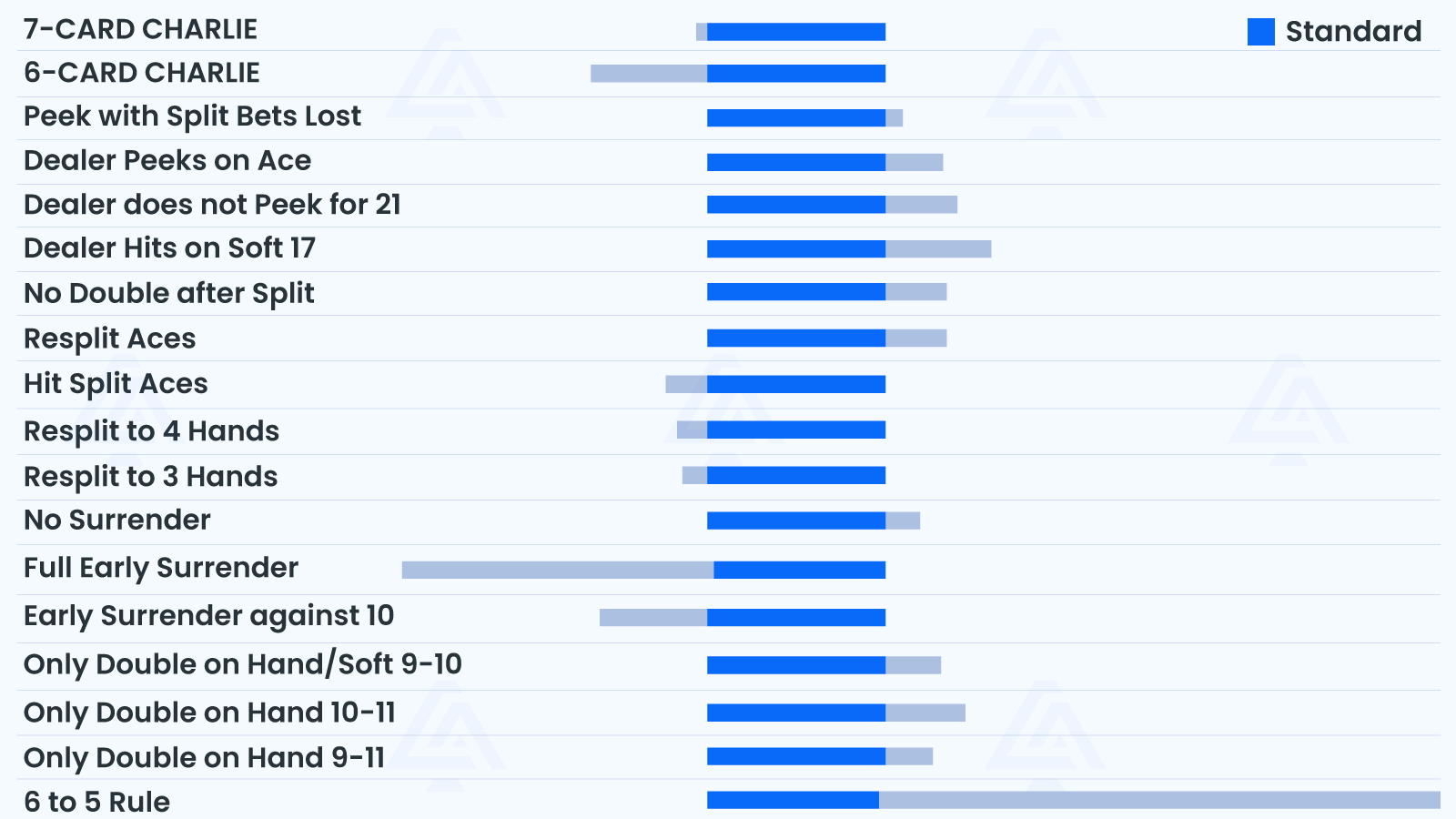
The number of decks also has an effect
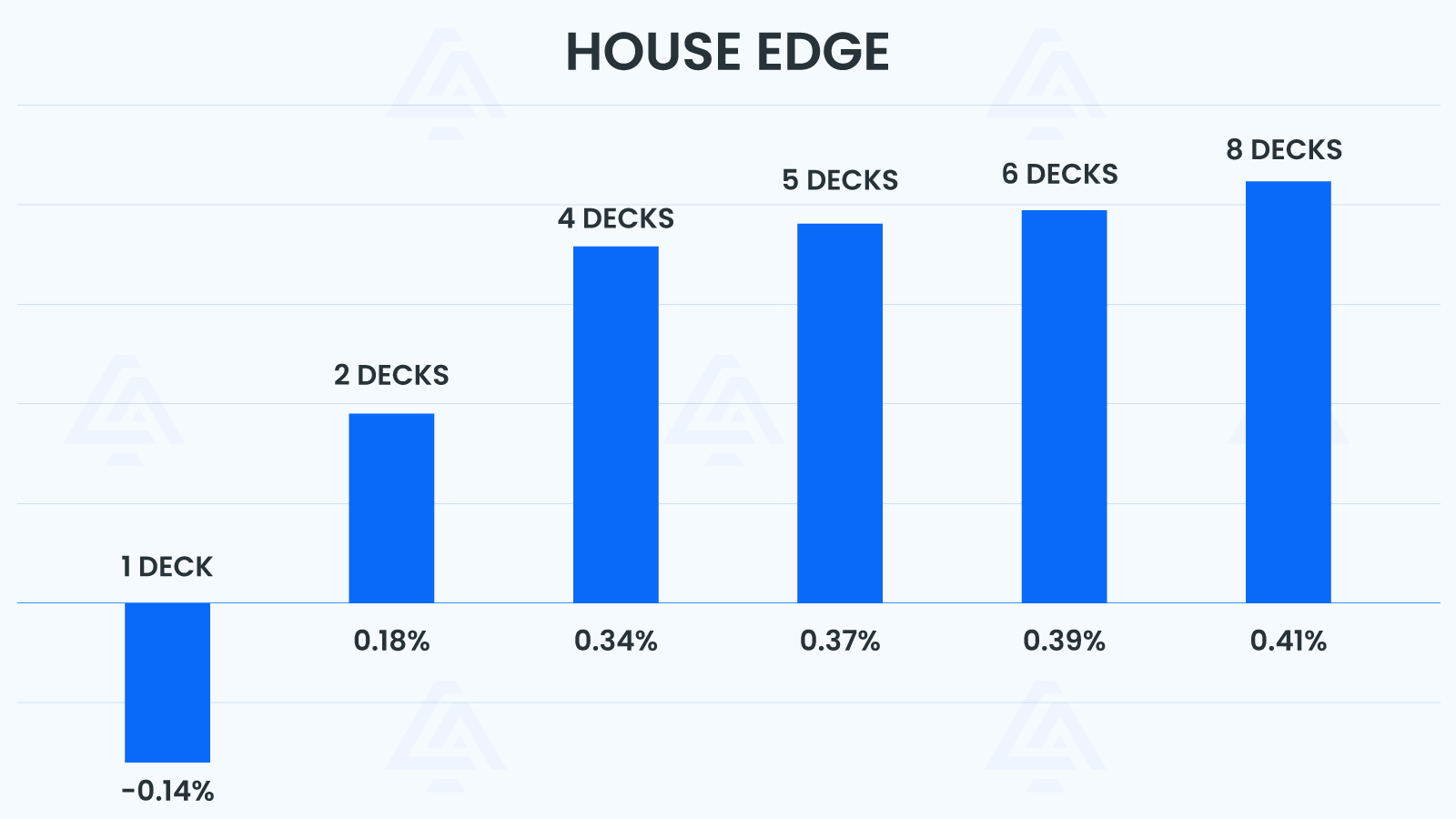
6 to 5 Blackjack: When It Might Be Your Only Option
Sometimes, despite your best efforts, 6:5 tables are your only option. Here’s how to minimize the damage.
The Low-Stakes Player’s Dilemma
Here’s the common situation: every 3:2 blackjack table has a minimum bet of £25 or more, but your bankroll only comfortably supports £5 to £10 bets. Then you spot the 6:5 tables—finally, a £5 minimum. You want to play, but the “affordable” option quietly costs you far more in the long run.
Cost-Benefit Analysis:
| Option | Pros | Cons | Verdict |
|---|---|---|---|
| Play 6:5 at £5 | Affordable, can play longer | Lose £1.50 per blackjack | Acceptable for short sessions |
| Play 3:2 at £25 | Better payouts | Risk of ruin, shorter sessions | Only if bankroll supports it |
| Play different game | Avoid 6:5 disadvantage | May not enjoy it as much | Consider roulette, baccarat |
| Don’t play | Preserve bankroll | No entertainment | Sometimes the best choice |
Recommendation: If you are going to play 6:5, at least consider limiting your session to 1-2 hours and treating it as entertainment expense, not an investment.
Damage Control Strategies
If you’re stuck at a 6:5 table:
- Reduce Your Session Length
- Optimize Your Bet Sizing
- Play Perfect Basic Strategy
- Avoid Side Bets
- Maximize Comps and Rewards
Better Alternatives to Consider
Other Casino Games with Better Odds:
| Game | House Edge | Compared to 6:5 Blackjack |
|---|---|---|
| Baccarat (Banker) | 1.06% | Better than 6:5 (1.9%) |
| Craps (Pass Line) | 1.41% | Better than 6:5 |
| European Roulette | 2.70% | Worse, but simpler |
| 3:2 Blackjack | 0.50% | Much better |
Online vs. Land-Based:
- Online casinos often have lower minimums on 3:2 games
- Live dealer blackjack typically maintains 3:2 payouts
- You can play from home at your own pace
- Easier to verify rules before playing
Bonus Hunting Strategy:
- Use casino welcome bonuses to play 3:2 games
- Check wagering requirements (blackjack often contributes 10-20%)
- Some bonuses allow you to play higher-stakes 3:2 tables
- Read terms carefully before claiming
When to Walk Away: If the only available tables are 6:5, the casino is telling you they don’t value your business. Consider taking your money elsewhere—there are always better options.
Tips to Improve Your Odds in 6 to 5 Blackjack

As you have seen, it’s nearly impossible to overcome the inherent disadvantage of 6:5 payouts. But then you can minimize additional losses.
6:5-Specific Strategy Adjustments
| Category | Key Points |
| Basic Strategy Remains the Same | The 6:5 payout does not change your optimal playing decisions. Continue to hit, stand, double, and split according to standard basic strategy. Do not try to “compensate” for the lower payout with aggressive play. |
| Insurance Bet Considerations | Insurance is always a losing bet in blackjack, and at 6:5 tables it’s even worse. Never take insurance, even if you have a blackjack—the math is not in your favor. |
| Side Bet Evaluation | Side bets usually have house edges between 3% and 8%. Combined with 6:5 payouts, your total disadvantage can reach 4–10%. Avoid all side bets at 6:5 tables and focus only on the main game. |
Table Selection Criteria
When You’re Stuck with 6:5 Blackjack
If every 3:2 table is out of reach, you can still look for rules that soften the blow. The best setup is one where the dealer stands on soft 17, late surrender is available, and you’re allowed to double after a split or even re-split aces. Each of these trims the house edge slightly — together, they can make the game less punishing.
When it comes to decks, fewer is technically better. But don’t fall for the “single deck” hype — a single-deck 6:5 game is still worse than an eight-deck 3:2. If you absolutely must play, the “least bad” table is a single-deck version with all those friendly rules in place. It’s playable, but still inferior to any proper 3:2 table.
Managing Your Bankroll at 6:5 Tables
Lower payouts mean faster losses, so your bankroll needs to stretch further. Expect to lose more per hour than you would at a 3:2 table. Cut your session bankroll by around 20–30%, set clear loss limits, and never chase to recover.
A healthy bankroll should sit at 50 to 100 times your average bet. For example, if you’re betting £10 per hand, you’ll want a £500–£1,000 session bankroll. Limit sessions to about two hours, take 15-minute breaks every hour, and leave once you’ve hit your loss limit — not when you feel due.
Making the Most of Comps and Rewards
If you’re going to lose a little faster, you might as well get something back. Always use your player’s card, ask about comp rates, and see if your playtime earns points, free play, meals, or rooms. Some casinos base comps on hours played rather than losses, so it pays to check.
High-tier players may even get access to better tables or VIP hosts who can arrange proper 3:2 games. Cashback programs help too, though they rarely balance the math. For instance, a 0.1% cashback rate gives you just £1 back on £1,000 lost — hardly redemption, but still worth claiming.
Is 6 to 5 Blackjack Worth Playing? Here’s What to Consider
The bottom line is that such games provide worse odds for players. The rule’s popularity is explicable only by the operators’ wish to limit player chances. While most developers will try to counterbalance the effects of this rule, it should become clear from the payouts chart that this specification has the heaviest toll on the house edge. While we can advise you to go for other game variations, you should freely decide on your own. Proceed with full knowledge of the facts, and use our research tips to enhance your odds and experience.




